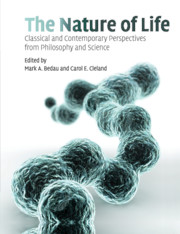Book contents
- Frontmatter
- Contents
- Preface
- Acknowledgments
- Sources
- About the authors
- Introduction
- SECTION I CLASSICAL DISCUSSIONS OF LIFE
- SECTION II THE ORIGIN AND EXTENT OF NATURAL LIFE
- SECTION III ARTIFICIAL LIFE AND SYNTHETIC BIOLOGY
- 16 Learning from functionalism: prospects for strong artificial life
- 17 Life, “artificial life,” and scientific explanation
- 18 Alien life: how would we know?
- 19 Automatic design and manufacture of robotic life forms
- 20 A giant step towards artificial life?
- 21 Approaches to semi-synthetic minimal cells: a review
- 22 Creating “real life”
- SECTION IV DEFINING AND EXPLAINING LIFE
- Supplementary bibliography on life
- Index
- References
21 - Approaches to semi-synthetic minimal cells: a review
Published online by Cambridge University Press: 10 November 2010
- Frontmatter
- Contents
- Preface
- Acknowledgments
- Sources
- About the authors
- Introduction
- SECTION I CLASSICAL DISCUSSIONS OF LIFE
- SECTION II THE ORIGIN AND EXTENT OF NATURAL LIFE
- SECTION III ARTIFICIAL LIFE AND SYNTHETIC BIOLOGY
- 16 Learning from functionalism: prospects for strong artificial life
- 17 Life, “artificial life,” and scientific explanation
- 18 Alien life: how would we know?
- 19 Automatic design and manufacture of robotic life forms
- 20 A giant step towards artificial life?
- 21 Approaches to semi-synthetic minimal cells: a review
- 22 Creating “real life”
- SECTION IV DEFINING AND EXPLAINING LIFE
- Supplementary bibliography on life
- Index
- References
Summary
THE NOTION OF MINIMAL CELL
The simplest living cells existing on Earth have several hundred genes, with hundreds of expressed proteins, which, more or less simultaneously, catalyse hundreds of reactions within the same tiny compartment—an amazing enormous complexity.
This picture elicits the question of whether or not such complexity is really essential for life, or whether or not cellular life might be possible with a much smaller number of components. This question is also borne out of considerations on early cells, which could not have been as complex. The enormous complexity of modern cells is probably the result of billions of years of evolution in which a series of defence and security mechanisms, redundancies and metabolic loops (which, in highly permissive conditions, were probably not necessary) was developed. These considerations led to the notion of minimal cell, now broadly defined as a cell having the minimal and sufficient number of components to be considered alive. This automatically precedes the next fundamental, but complex, question, “What does ‘alive’: mean?” One may choose quite a general definition, defining life at a cellular level as the concomitance of three basic properties: self-maintenance (metabolism), self-reproduction and evolvability (Fig. 21.1).
Evolvability is a Darwinian notion. As such, it refers to populations rather than individual cells. Consequently, one should take into consideration an entire family of minimal cells in the stream of environmental pressure and corresponding genetic evolution.
- Type
- Chapter
- Information
- The Nature of LifeClassical and Contemporary Perspectives from Philosophy and Science, pp. 272 - 288Publisher: Cambridge University PressPrint publication year: 2010



